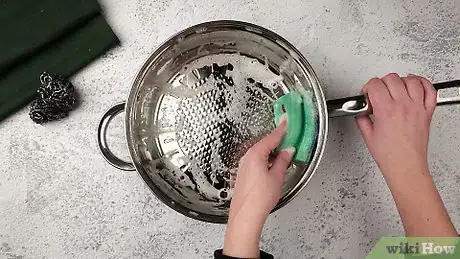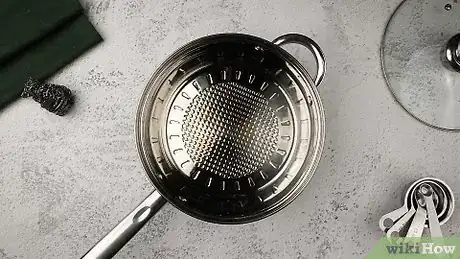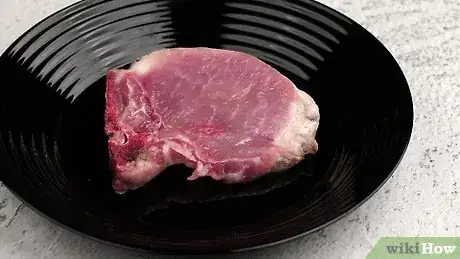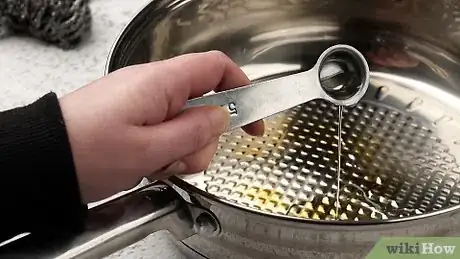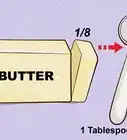This article was co-authored by Abyssinia Campbell and by wikiHow staff writer, Luke Smith, MFA. Abyssinia Campbell is an Executive Chef and the Owner of Chef Abyssinia, Personal Chef and Catering. With over ten years of experience, she specializes in catering, event planning, menu development, meal planning, and food business operations. When it comes to cooking, Chef Abyssinia enjoys using fruits, vegetables, healthy food alternatives, and local farm-fresh ingredients. She holds a BASc in Culinary Arts and Food Service Management from Johnson and Wales University.
There are 7 references cited in this article, which can be found at the bottom of the page.
This article has been viewed 262,429 times.
It’s always much easier to cook with pans that don’t stick; however, the majority of nonstick pans on the market contain harmful chemicals that make them less than ideal for cooking. Steel pans are fabulous for cooking meats and veggies, but tend to cling to the food they cook. While you don’t technically need to season a stainless steel pan, doing so can add a non-stick sheen that ensures your food comes off the pan intact, without leaving behind any bits. Add oil to a clean stainless steel pan and let it heat to kick off the seasoning process. Afterward, you’ll be able to use your freshly seasoned pan to whip up all kinds of tasty meals for you and your family!
Things You Should Know
- Wash your stainless steel pan with dish soap and warm water to ensure that the seasoning oil takes.
- Season your pan over medium heat with a high-smoke point oil, like grapeseed or canola oil.
- Compost or dispose of the excess seasoning oil in a sealed container.
- Store your stainless steel pans between layers of paper towels to prevent scratches and scuffs.
Steps
Seasoning
-
1Wash your pan with dish soap and warm water. Scrub the pan with dish soap and a dishrag or sponge. Clean both the inside and outside of the stainless steel pan as thoroughly as you can. Rinse the pan off with warm water, then let it air dry.[1] Oil will adhere better to a clean pan.
- Scrub the pan with baking soda and a scouring pad to remove tougher stains.
-
2Choose an oil with a high smoking point to season your pan with. Sesame, grapeseed, peanut, and canola oil are all great choices for seasoning your pan.[2] An oil with a high smoking point will react more readily to the heat as you begin the seasoning process, and will “stick” better to the pan. This helps your seasoning to last longer and be more effective.[3]
- Other suitable oils include avocado oil, sunflower seed oil, and soybean oil.
Advertisement -
3Pour just enough oil into the pan to thinly coat the bottom. For most pans, this will measure out to about 2 tablespoons (30 ml) of oil. Swirl the pan around to spread the oil to the sides. Aim to cover the inside of the pan as thoroughly and evenly as possible so the entire interior is seasoned for cooking.[4]
-
4Heat your pan on the stove for 3 minutes over medium heat. Avoid cranking the burner up to high to start off the seasoning process; this will cause the pan to heat unevenly and may burn the oil. Medium heat is not only gentler on the pan and the oil, but will ensure they heat up at an even rate.[5]
-
5Remove the pan from the heat once the oil starts to smoke. The oil is ready once thin wisps of smoke begin curling up from the pan. It may take around 3 to 5 minutes for this to develop. Immediately take the pan off of the burner and move it to another burner.
-
6Let the oil cool for at least 30 minutes. The oil should at least be lukewarm, if not room temperature. You want the oil to be cool enough to not scald to the touch. This will ensure the oil is safe enough to handle for the rest of the seasoning process. Ideally, let the pan with with the oil overnight.[6]
- Don’t touch the oil to test whether it’s cooled down enough.
-
7Pour the excess oil into a sealed container, and throw the container away. You will still be able to see some oil in the pan once you’ve finished; this is okay. Pour the oil into a container with a sealable lid (like a leftover glass jar), then seal the container and dispose of the oil in the trash.
- You can also compost your leftover oil, or ask a nearby community garden if they can make use of it.
- Never dispose of leftover cooking oil in your kitchen sink drain. Cooking oil is a pollutant, and can damage your pipes.
-
8Wipe the inside of the pan with a paper towel. Wad up the paper towel and run it along the pan in circular motions. This will both sop up any remaining excess oil, as well as give the pan a noticeable shine. The shininess indicates the pan has been sufficiently glossed and is now nonstick![7]
Preventing Sticking
-
1Preheat your pan to medium heat before cooking. Doing this will ensure your pan and food heat evenly, and prevent the likelihood of burnt cooking. It should take around 2-4 minutes for your pan to reach medium temperature. Avoid setting the burner to high when you use any pan—especially a seasoned pan. The higher the cooking temperature, the more likely your food will stick to the pan as it cooks[8]
- You’ll know it’s ready if, when you add a drop of water, the water beads and moves easily across the surface of the pan, rather than simply pooling in place.
-
2Thaw foods to room temperature before you cook. Cold food will ultimately stick to hot pans, causing burning and creating a mess. Let your food thaw in the refrigerator, but take it out for 1 to 2 hours before cooking so it can rise to room temperature.[9]
- Don’t let raw food sit out for any longer than 2 hours, or you increase the risk of bacteria and food poisoning!
-
3Don’t crowd the pan with ingredients. Filling your pan up with more ingredients than it can hold leads to unbalanced temperatures and sticking. If you want to cook multiple ingredients in the same pan, stick to only 2 or 3 at a time, and space them out so they each have their own section in the pan.[10]
-
4Cook acidic foods, water-based foods, and sauces in your stainless steel pan. Fruits, veggies, tomato sauce, gravies, and broths are all great foods to cook in a seasoned stainless steel pan. Alternatively, you can use your pan to pan-fry your morning eggs, or sear a cut of salmon for dinner. Stainless steel pans are best designed for cooking these types of foods.[11]
- Stainless steel pans are great for proteins like chicken and steak, but expect some sticking when cooking these, and season your pan beforehand to prevent as much sticking as possible.
Storing and Cleaning
-
1Wipe your pan out with a paper towel once you finish cooking. Washing a seasoned pan with soap and water after every cooking session will strip away the oil, forcing you to reseason. The oil left in the pan is meant to protect it from stuck-on food, making soap and water unnecessary until your pan becomes too messy to use.[12]
-
2Clean out a messy pan with soap and water. Eventually, your seasoned pan will become messy with residue. In this case, it’s fine to clean it out. Use warm water and a nonabrasive cleaning tool, like a soft sponge or cloth dishrag.[13]
- Don’t wash your pan until it is totally cool to the touch.
- Wipe your pan dry with a paper towel as soon as you finish washing it. This will keep it from spotting.
-
3Remove stubborn, stuck-on food by boiling water for 5 minutes. If there's any residue left over, add dish soap to the pan before submerging the residue with water. Place the pan on the stove and turn the burner on high. Let the pan boil for 5 minutes, then pour out the hot water. The rest of the residue should scrub right off![14]
-
4Reseason your pan with fresh oil after you wash it. Once you wash your pan with soap and water, it's no longer seasoned. To make sure it continues to be a perfect, non-stick pan, repeat the seasoning process!
-
5Place a few paper towels inside your seasoned pan before stacking it. Stacking pans is a common and useful storage method, but it can easily scratch up the insides of your pans. A scratched pan can’t be seasoned as effectively. Layering a few paper towels or squares of parchment paper inside will give your seasoned pan the protection it needs.[15]
Community Q&A
-
QuestionHow do I season a red copper pan?
 Ashley RidgeCommunity AnswerYou can season a red copper pan using the same method as you would a stainless steel pan. Add oil to the pan, then heat it up until it smokes. Take it off the burner so it can cool down completely. Pour out the oil and wipe out the pan with a paper towel. Hope this helps!
Ashley RidgeCommunity AnswerYou can season a red copper pan using the same method as you would a stainless steel pan. Add oil to the pan, then heat it up until it smokes. Take it off the burner so it can cool down completely. Pour out the oil and wipe out the pan with a paper towel. Hope this helps! -
QuestionDo I season the pan every time I wash with soap and boil?
 Community AnswerYes, although I highly recommend avoiding using soap if possible.
Community AnswerYes, although I highly recommend avoiding using soap if possible.
References
- ↑ https://www.nytimes.com/wirecutter/guides/how-to-clean-stainless-steel-pans/
- ↑ https://kitchenicious.com/best-oils-for-seasoning-stainless-steel-pans/
- ↑ https://www.mayoclinic.org/healthy-lifestyle/nutrition-and-healthy-eating/expert-answers/cooking-oil/faq-20058170
- ↑ https://www.kitchensanity.com/cookware/how-to-season-a-stainless-steel-pan/
- ↑ https://www.kitchensanity.com/cookware/how-to-season-a-stainless-steel-pan/
- ↑ https://www.kitchensanity.com/cookware/how-to-season-a-stainless-steel-pan/
- ↑ https://www.kitchensanity.com/cookware/how-to-season-a-stainless-steel-pan/
- ↑ https://prudentreviews.com/stainless-steel-pan-food-sticks/
- ↑ https://prudentreviews.com/stainless-steel-pan-food-sticks/
- ↑ https://prudentreviews.com/stainless-steel-pan-food-sticks/
- ↑ https://prudentreviews.com/stainless-steel-pan-food-sticks/
- ↑ https://www.kitchensanity.com/cookware/how-to-season-a-stainless-steel-pan/
- ↑ https://food52.com/blog/15027-our-guide-for-caring-for-cleaning-stainless-steel-pans
- ↑ https://food52.com/blog/15027-our-guide-for-caring-for-cleaning-stainless-steel-pans
- ↑ https://thegourmetinsider.com/cookware-how-to-store-cookware/
About This Article
Seasoning a stainless steel pan is a natural way to reduce sticking and keep your pan from getting rusty. To season your pan, start by washing the pan with dish soap and warm water. Rinse the pan thoroughly and let it air dry. Next, choose an oil with a high smoke point, such as sesame, vegetable, peanut, or soybean oil. Pour about 2 tablespoons (30 mL) of the oil into the pan, then swirl the pan around to evenly coat the bottom and sides. Heat the pan over medium heat on the stove for 2 to 5 minutes, or until the oil begins to smoke. As soon as you see any smoke rising from the pan, immediately move it off the burner and turn off the heat. Let the oil cool for 30 minutes, then pour it out of the pan or soak it up with a clean paper towel. Wipe the remaining oil out of the pan with a paper towel using circular motions. To keep your seasoned pan in good condition, always preheat it to medium for about 10 minutes before cooking. This will help your food heat more evenly and prevent it from burning and sticking. Avoid cooking anything in a seasoned pan on high heat. You can also minimize sticking by thawing frozen foods to room temperature before cooking them and making sure not to overcrowd the pan with too many ingredients. Some types of foods work better in seasoned pans than others, so stick to dishes like sauces, vegetables, gravies, and broths. They also work well for frying or searing proteins like eggs and fish. When you’re done cooking, gently wipe the pan with a dry paper towel. To prevent scratches, put a layer of paper towels in the bottom of the pan before stacking other cookware inside of it. It’s okay to wash a seasoned pan with soap and water if it gets very soiled and greasy. You can also soak off stubborn gunk by boiling water in the pan for 5 minutes. When you’re done, wipe away any remaining residue and re-season your pan before using it again. For more tips, including how to store your seasoned pan, read on!
